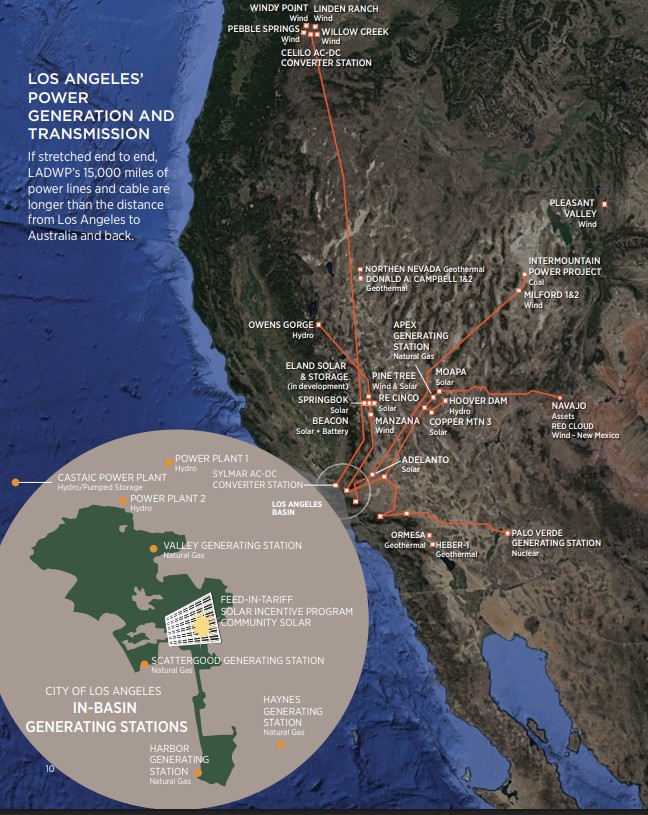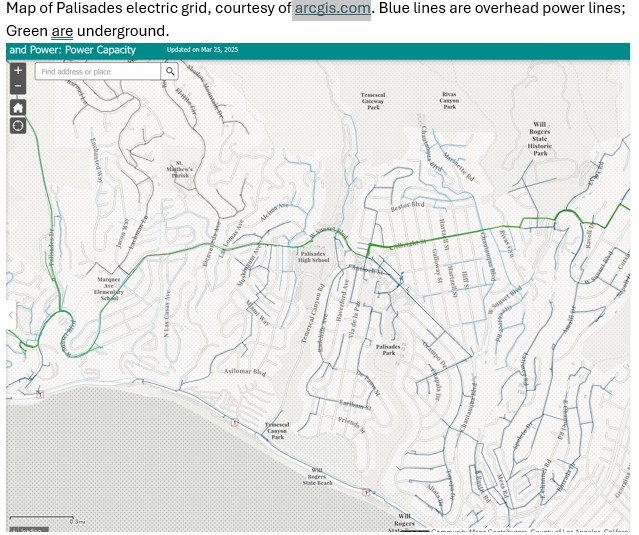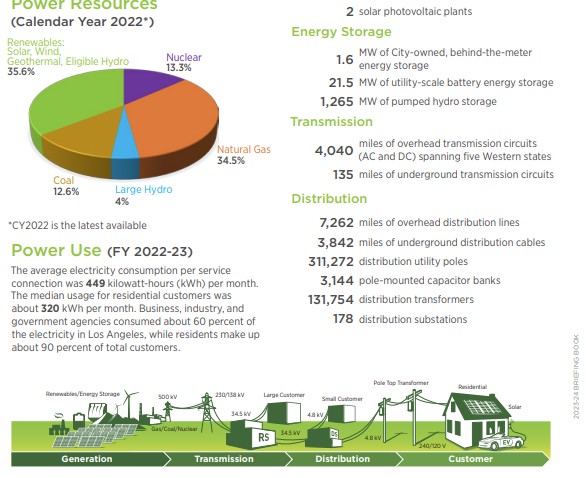(Editor’s note: As homes and cars have become increasingly mandated all-electric in Los Angeles, I asked reporter Chaz Plager to find out where Palisades electricity comes from. Many of us have no idea how it is made, and assume it’s sort of magical and just appears.)
By CHAZ PLAGER
Following the devastation of the Palisades fire, there has been an emerging initiative among those trying to rebuild— the idea that we can do more than just rebuild: we can rebuild the Palisades better than it ever was. And part of that initiative is implementing new underground electrical wiring.
However, implementing underground wiring is a costly endeavor, with estimates from LADWP saying burying power lines could cost from $1 million to $14 million per mile of wiring. Here’s everything we know about the electricity situation in the Palisades so far.
Where Palisades’ Electricity Comes From
There is a DWP Distribution Station 29 in the Palisades at Via de la Paz and Sunset, built in 1935, but that is not where the Palisades’ energy is produced. According to LADWP, our power is produced through “vertically-integrated power generation, transmission, and distribution systems that span over five Western U.S. states.
“Power at any location in the City can come from any of the DWP generating stations in the Southwestern U.S. or Northward to the LA Aqueduct or Canada (Bonneville Power along the Pacific DC Intertie).”
In short, Palisades power doesn’t really come from any one particular place, but rather is hooked up to a grid of several power plants across the West Coast. Sort of like evenly distributing water throughout a cardboard maze. There is a map in LADWP’s Briefing Book on page 10 that illustrates this best (map above).
Each of these plants that send electrical power to the Palisades use varying power production methods, from natural gas, to coal, to hydroelectric to nuclear. Detailed statistics can be found at Power Content Label | Los Angeles Department of Water and Power (ladwp.com)
Map of Palisades electric grid, courtesy of arcgis.com. Blue lines are overhead power lines; Green are underground.
It is also worth noting that on page 4, one of DWP’s Strategic Initiatives is “Leading with Equity,” which means DWP is “Powered by Equity” a collection of clean energy programs and polices and “Project Powerhouse.”
Powerhouse was launched in response to Mayor Karen Bass’ declaration of emergency on homelessness, which would prioritize 100 percent affordable housing. DWP also amended a rule to allow sharing the cost of underground distribution line extensions in the public right of way to all customers who benefit.
Will Residents Have to Pay for New Wiring?
On the phone with LADWP, this reporter asked their representative, Chelsea, if the millions of dollars in costs would be passed on to customers of LADWP. Her response? “It shouldn’t be,” she said. “Under normal circumstances, the customer would have to pay for their new wiring, but considering that it’s a natural disaster, we can expect the city or the state to shell out funding to get the wiring completed.”
Now, the city and state get their funding from their taxpayers, so does that mean there will be federal funding to support undergrounding electrical wires in the Palisades?
Will Newly Built Homes Be Required to be All-Electric?
There have been rumors of new Palisades houses only being able to use electricity rather than alternative sources of energy such as natural gas. When this reporter asked Chelsea about this, she replied “I can’t imagine that being the case. There’s no reason why the houses should only be able to use electricity instead of solar or wind.”
That statement didn’t make a lot of sense because electricity is generated via solar or wind.
Some residents who had solar panels on their homes, and if there excess electricity generated, that energy went back to the grid. At a recent press conference, a DWP rep said if those same homeowners rebuild they will receive the credit from that electricity from their prior home. DWP is not able to pay cash for the generated energy to the grid. That credit will not transfer to a new home builder.
Los Angeles passed a general ordinance (No. 187714) in 2022 requiring all new construction to be all-electric, as of April 2023.
After the fires in the Palisades, Mayor Karen Bass waived (and recently extended) this ordinance specifically for new Palisades houses, meaning that if you’re rebuilding, you can use electric or gas or both (provided you’re okay missing out on tax incentives). But considering that natural gas costs about $0.097 per kilowatt versus $0.50 per kilowatt using electricity, you may find it cheaper than using tax incentives.




One wonders if the city will actually underground electric everywhere in the Palisades and especially to those”gray line” areas, as promised when the cameras were on, now that they have installed above ground transformers throughout the community, now that the cameras are off.